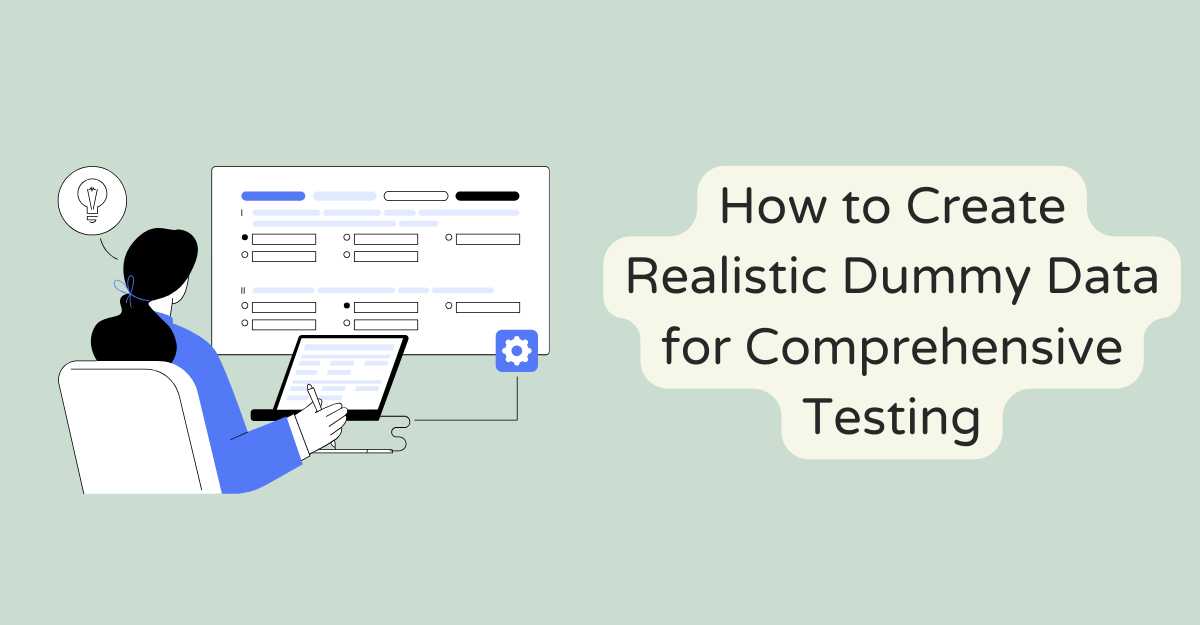
How to Create Realistic Dummy Data for Comprehensive Testing
In the ever-evolving landscape of software development and testing, the creation of realistic dummy data stands as a crucial phase. This process not only supports the testing of applications under conditions that closely mimic live environments but also ensures that software is robust, reliable, and ready for deployment. Among the myriad of tools and techniques available for generating such data, the RNDGen Dummy Data Generator emerges as a noteworthy mention for its versatility and effectiveness in simulating a wide array of data types. Here, we delve into strategies and best practices for creating comprehensive and realistic dummy data for testing.
Understanding the Importance of Dummy Data
The importance of dummy data in software testing cannot be overstated. It is the linchpin that ensures applications are not only functional but also robust and secure across various use cases. Dummy data allows for a comprehensive evaluation of software applications in a controlled, risk-free environment, simulating real-world conditions without the need to expose sensitive or real user data. This approach is invaluable for several reasons:
Ensures Data Privacy and Security
Using dummy data helps maintain the privacy and security of real data. By avoiding the use of actual user information, developers can prevent potential data breaches and comply with data protection regulations such as GDPR and CCPA. This is particularly crucial for applications that handle sensitive information, where the implications of a data leak could be catastrophic.
Facilitates Scalability Testing
Dummy data enables developers to test the scalability of their applications. By generating data in volumes that mirror or exceed expected real-world usage, developers can observe how their application performs under stress or heavy loads. This is essential for identifying and addressing performance bottlenecks before they impact end-users.
Supports a Wide Range of Test Cases
With realistic dummy data, testing can cover a broader spectrum of scenarios, including edge cases that may not be readily apparent. This thorough testing ensures that the application can handle unexpected inputs or situations gracefully, reducing the risk of crashes or unexpected behavior in production.
Enhances Quality Assurance
Quality assurance (QA) teams rely heavily on dummy data to execute test plans effectively. By using data that closely mimics real user scenarios, QA can verify not just the functionality but also the user experience, ensuring that the software meets all requirements and specifications.
Accelerates Development Cycles
The availability of dummy data allows for parallel development and testing efforts. Developers and testers can work simultaneously, with testers using dummy data to validate new features or changes without waiting for production data. This parallel processing can significantly reduce development timelines and accelerate time to market.
Enables Safe and Effective Training Environments
Dummy data is not just useful for testing; it’s also invaluable for training purposes. New users or employees can train on realistic data without the risk of affecting real operations or exposing sensitive information. This creates a safe learning environment that closely replicates actual system use.
Selecting the Right Tools
The choice of tool for generating dummy data can significantly affect the realism and utility of the testing phase. Choose a tool that seamlessly integrates with your development and testing environments. Compatibility reduces setup time and facilitates smoother workflows, allowing teams to generate and utilize dummy data with minimal friction. While there are several options available, RNDGen stands out for its ability to generate a wide variety of realistic data patterns, making it an ideal choice for developers looking for an all-encompassing solution.
Best Practices for Creating Realistic Dummy Data
Understand Your Data Requirements
Begin by thoroughly analyzing your application’s data requirements. Understanding the types of data your application handles (e.g., personal information, transactional data, psychometric assessment, etc.) is crucial in creating effective dummy data.
Use Varied Data Types
Ensure your dummy data encompasses a wide range of data types and structures to fully test your application’s handling of different inputs. This includes text, numbers, dates, and even complex data structures.
Simulate Real-World Scenarios
The goal of dummy data is not just to fill databases but to replicate real-world usage scenarios as closely as possible. This involves creating data sets that reflect the complexity and variability of real user data.
Prioritize Data Privacy
When generating dummy data that mimics personal or sensitive information, it’s essential to ensure that the data does not infringe on privacy rights or expose real information. Tools like RNDGen are designed to generate data that is realistic yet entirely fictional.
Automate the Data Generation Process
To streamline the process and ensure consistency across tests, automate the generation and deployment of dummy data. Automation also allows for easy scaling as your testing requirements grow.
Test With Volume
Volume testing with dummy data can reveal how your application performs under load. Generating large volumes of data can help identify bottlenecks and performance issues that may not be apparent with smaller data sets.
Conclusion
Creating realistic dummy data is a critical step in comprehensive software testing, ensuring that applications are thoroughly evaluated before release. By leveraging powerful tools like RNDGen Dummy Data Generator and following best practices, developers can simulate real-world scenarios accurately, uncover potential issues early in the development cycle, and pave the way for successful software deployments.
Remember, the key to effective testing lies not just in generating data, but in generating data that truly represents the complexities and challenges of real-world application use.






